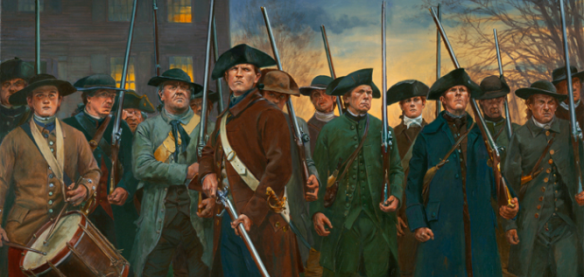The last of the French and Indian Wars, 1754 – 63, opened with attempts first by Virginia volunteers (raised outside the militia system) commanded by George Washington, then by British regulars commanded by Edward Braddock to seize control of the forks of the Ohio River from France. Though not used to raise men until 1757, the militia system proved efficient enough to muster men from New York, New Jersey, Rhode Island, and Massachusetts for John Bradstreet ‘ s 1758 expedition that captured Fort Frontenac on the St. Lawrence River in 1758. William Byrd II commanded the Virginia, Maryland, Delaware, and North Carolina militiamen who accompanied the British regulars who drove the French from Fort Duquesne at the forks of the Ohio (Selesky 1990, Titus 1991, Ward 2003). Though they worked together colonial militiamen and British regulars did not get along and this experience reinforced American distrust of standing armies of professional soldiers (Leach 1986, Johnson 1992).
The French and Indian War resuscitated the militia system and gave colonial leaders experience in working together on military matters, but, in general, militia did not perform well on extended campaigns away from their immediate homelands, indeed many deserted. On the eve of the American Revolution the 13 colonies had a total of 500,000 men enrolled in the militias, one – third of the entire population of those colonies. As tensions between Americans and the mother country escalated, leaders of what would become the Patriot cause gained control of most militia units purging officers loyal to Britain (Shy 1975). Militia officers often assumed leadership roles in committees of correspondence, Sons of Liberty, and committees of public safety that organized opposition to British policies and enforced non – importation, non – consumption agreements. In 1774 and 1775 the Continental Congress instructed colonial governments to reorganize their militias and gather arms and ammunition. The revolutionary government in Massachusetts ordered all commanders to designate a portion of those under their command to be ready for instant service. Thus were born the Minutemen who opposed British regulars at Lexington, Concord, and Bunker Hill and laid siege to the British in Boston (Fischer 2004).
Those units were subsequently formed into the Continental Army during 1776. From 1777 to the end of the war the “American army ” would consist of Continental Army ” regulars ” who were organized as state ” lines, ” whose ranks state governments were responsible for filling with volunteers or conscripts; by state troops which were raised in a variety of ways, and local militia units that were usually called to serve for short periods of time when their state was threatened (Alexander 1945, 1947 , Murphy 1959 – 60 , Royster 1979 , Buel 1980 , Kestnbaum 2000 ). Mark Kwasny (1998) traces the evolution of the militia and George Washington’s employment of militia units as the war progressed concluding that they came to form an important component of his campaigns. In 1776 Charleston was defended by a force of 900 Continentals, 2,000 state troops, and 2,700 local militia. The August 16, 1777 defeat of a force of 1,250 British troops by 2,000 New Hampshire and Massachusetts militia at Bennington, Vermont, laid the basis for Major General John Burgoyne ‘ s surrender at Saratoga two months later. Brigadier General Daniel Morgan made effective use of militia units at Cowpens, South Carolina, in January 1781, and George Washington had three brigades of Virginia militia at Yorktown. In addition to providing a system through which governors could raise state armies for operations such as the Virginian campaign that captured British posts in the Old Northwest or the Massachusetts – organized debacle at Penobscot, militia conducted most operations against Britain’s Indian allies and kept in check Loyalists away from the main theaters of operations (Higginbotham 1971, Ferguson 1978, Galvin 1989, Clements and Wright 1989, Resch and Sargent 2007). Patriot militiamen inflicted significant defeats on Loyalist American militiamen at Moore’s Creek Bridge, North Carolina, in February 1776 and at Kings Mountain, South Carolina, in October 1780. Militia successes were balanced by failures, for example, at Groton Heights in Connecticut in 1781 and at Blue Licks in Kentucky in 1782, and many commanders, with reason, considered militiamen unreliable. Dissatisfied with the performance of Virginia ‘ s militia during the war, governor Patrick Henry sought to reorganize it during the 1780s and met resistance from local governmental officials (Ethridge 1977 , Waghelstein 1995 ).
During the late 1780s insurrections occurred in South Carolina, Virginia, Maryland, Pennsylvania, New Jersey, and Massachusetts where militia units from the eastern portion of the state subdued Shay ‘ s Rebellion in the west (Szatmary 1980 ). When these were followed by the Whiskey Rebellion and Fries Rebellion during the 1790s it appeared for a while that domestic civil unrest might pose a greater threat to American society than any foreign enemy.
Nonetheless, always warned to fear a standing army, Americans relied, at least in theory, on militia as their first line of defense against enemies domestic and foreign for the half century of their independence (Cunliffe 1968, Crackel 1987). Richard Kohn (1975) shows that during the 1790s the Federalists created and stationed a standing force of army regulars on the frontier, and Lawrence Cress (1981) argues convincingly that within a decade, despite Republican rhetoric, most American leaders accepted, at least tacitly, a force structure in which regulars formed the core around which militia would build in time of danger.
